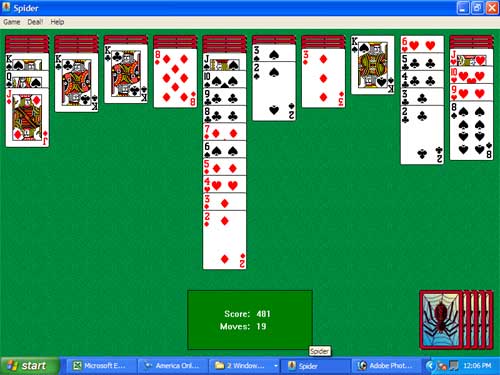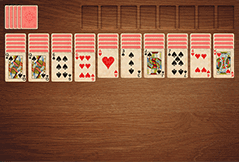

- #El original spider solitaire windows how to#
- #El original spider solitaire windows windows 10#
- #El original spider solitaire windows windows 8#
Fifty-four of the cards are laid out horizontally in ten columns with only the top card showing. The game is played with two decks of cards for a total of 104 cards.
#El original spider solitaire windows windows 10#
Windows 10 has the Microsoft Solitaire Collection app updated and bundled with the OS.
#El original spider solitaire windows windows 8#
Finally, Windows 8 has another updated version available in the Windows Store as part of Microsoft Solitaire Collection but not bundled with the operating system. Windows Vista again saw a new version, which was mainly unchanged in Windows 7. Spider Solitaire was not included in Windows 2000, but was added to Windows Me and later on Windows XP the game gained popularity subsequent to its inclusion in the latter. The game was first included as part of Windows 98's Microsoft Plus! package on its release on Jand has been since featured on most subsequent versions of Windows. As of 2005, it was the most played game on Windows PCs, surpassing the shorter and less challenging Klondike-based Windows Solitaire. Spider Solitaire, also known as Microsoft Spider Solitaire ( Spider in the About box in some versions), is a solitaire (NA)/patience (EU) card game that is included in Microsoft Windows.
#El original spider solitaire windows how to#
Read more on our how to play solitaire guide, and learn about solitaire strategies here.Microsoft Solitaire Collection on Windows 10, in Spider mode If you get stuck, you can use our hint button to help you identify which cards to move around, or you can start a new game. Keep in mind that not all games are winnable.

Win by moving all the cards to the Foundation piles in the right order. If a tableau column is empty, you may move a King, and only a King, to that column.ħ. As cards are surfaced from the stockpile or tableau, and there are no other cards on top of them, they may be moved to a foundation pile if they can be placed in the right order.Ħ. Once a foundation pile is started, only cards of that suit can be placed in that specific pile.ĥ. To start a foundation pile, an Ace must be played. If a tableau column has only face-down cards remaining, the last card is flipped over and can be played.Ĥ. Groups or stacks of sequenced cards in the tableau can also be moved together on top of a card of the opposite color and higher rank.ģ. Face up cards in the tableau or stockpile can be moved on top of another face up card in the tableau of an opposite color that is one rank higher, forming a sequence of cards.Ģ. Once all cards are turned over, the remaining cards that have not been moved to either the tableau or foundation can then be redrawn from the stockpile in the same order.ġ. If not used, the cards are put into a waste pile.

Stockpile: This is where you can draw the remaining cards, which can then be played in the game. The last card of every pile is turned over face up. Tableau: This is the area where you have seven columns, with the first column containing one card and each sequential column containing one more additional card. Goal:To win, you need to arrange all the cards into the four empty Foundations piles by suit color and in numerical order, starting from Ace all the way to King.

In our game, this is automatically done for you!Īll leftover cards after the foundations are created become the “Stock,” where you can turn over the first card. Only the last card in each of the Tableau columns is flipped over face up so you can see it’s suit, color and value. Ultimately, you will have seven piles, with the first pile containing one card, the second pile containing two cards, the third pile containing three cards etc. The eighth card distributed will go into the second column, since the first column already has its one and only card.Īfter the piles are complete, they should be cascaded downwards such that they form a “reverse staircase” form towards the right. As an example, this means the first seven cards will create the seven columns of the Tableau. The tableau increases in size from left to right, with the left-most pile containing one card and the right-most pile containing seven. Game setup: After a 52-card deck is shuffled you’ll begin to set up the tableau by distributing the cards into seven columns face down, with each new card being placed into the next column.


 0 kommentar(er)
0 kommentar(er)
